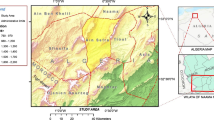Abstract
The highly increasing demand for sand in Northeastern Brazil, due to governmental economic incentive focused to this region, has necessitated the opening of new extraction mines, generally without adequate environmental control. This study aimed to assess several sand extraction activities in the Recôncavo territory, Bahia state—area with high variability in sedimentary deposits—by evaluating the quality of the sand and the extraction impacts according to the geological basement. The methodology consisted of field research, using satellite images and maps for characterization, application of the environmental and economic impact checklists, and analysis of organic matter, particle size distribution, and salt content in 35 samples from different sand mines. The sands were classified as white sand (from Neossols/weathered aeolian sandstones), brown sand (from mature soils), and river sand. A strong relation between the geological origin and sand type and quality was established. Although the river sand appears to be the best option for extraction with regards to sand quality and low environmental impacts, the white sand derived from Jurassic sandstones is intensively extracted due to easy access, availability of wide deposits, and visual quality and homogeneity. However, the white sand has an inadequate particle distribution due to its poor gradation (aeolian selection of fine particle) and high environmental impacts due to its location in wet tropical ecosystem dominated by the Atlantic forest and the erosion of sandy soils. We demonstrated that the knowledge of lithology is fundamental for mapping new potential sand mines and minimizing the generated impacts.











Similar content being viewed by others
References
Al-Ansary M, Pöppelreiter MC, Al-Jabry A, Iyengar SR (2012) Geological and physiochemical characterisation of construction sands in Qatar. Int J Sustain Built Environ 1:64–84
Al-Harthy AS, Halim MA, Taha R, Al-Jabri KS (2007) The properties of concrete made with fine dune sand. Constr Build Mater 21:1803–1808
da Silva AJP, da Lopes RC, Vasconcelos AM, Bahia RBC (2003) Paleozoic and meso-cenozoic sedimentary basins. In: Bizzi LA, Schobbenhaus C, Mohriak WU (eds) Geologia, tectônica e recursos minerais do Brasil. CPRM, Brasília, pp 55–85
Dalton de Souza J, Kosin M, Melo RC et al (2003) Mapa geológico do Estado da Bahia-Escala 1:1.000.000. CPRM, Salvador
Departamento Nacional de Produção Mineral (2015) Sumário Mineral. DNPM, Brasília
Dias ACCP, Demattê JLI (1977) Mineralogia de alguns solos da bacia sedimentar do Recôncavo Baiano. An da Esalq-USP 34:61–70
Elipe MGM, López-querol S (2014) Aeolian sands: characterization, options of improvement and possible employment in construction—The State-of-the-art. Constr Build Mater 73:728–739
Gonçalves JCV, Moreira MD, Borges VP (2008) Mapa Geológico e de Áreas Potenciais para areia, arenoso, e brita da região metropolitana de Salvador-Série Rochas e Minerais Industriais. CPRM, Salvador
Krumbein WC, Sloss LL (1963) Stratigraphy and sedimentation. Freeman, San Francisco
La Rovere EL (2001) Instrumentos de planejamento e gestão ambiental para a Amazônia, cerrado e pantanal: demandas e propostas-metodologia de avaliação de impacto ambiental. IBAMA, Brasília
Luo FJ, He L, Pan Z et al (2013) Effect of very fine particles on workability and strength of concrete made with dune sand. Constr Build Mater 47:131–137
Mohriak WU (2003) Sedimentary basins of the Brazilian continental Margin. In: Bizzi LA, Schobbenhaus C, Mohriak WU (eds) Geologia, tectônica e recursos minerais do Brasil. CPRM, Brasília, pp 87–94
Neville AMTS (1982) Propriedades do concreto. PINI, São Paulo
Nobre Filho PA, Beltrão Sabadia JA, Duarte CR et al (2011) Impactos ambientais da extração de areia no canal ativo do Rio Canindé, Paramoti, Ceará. Ceará Rev Geol 24:126–135
Padmakumar GP, Srinivas K, Uday K V et al (2012) Characterization of aeolian sands from Indian desert. Eng Geol 139–140:38–49
Saporetti-Junior AW (2009) Vegetation and soils of Mussununga of Caravelas, Bahia State. Federal University of Viçosa
United State Geological Survey (2016) Mineral Commodity Summaries. US Geological Survey, Reston
Yeomans JC, Bremner JM (1988) A rapid and precise method for routine determination of organic carbon in soil. Commun Soil Sci Plant Anal 19:1467–1476
Acknowledgements
The study was supported by a grant from the “Fundação de Âmparo à Pesquisa do Estado da Bahia”.
Author information
Authors and Affiliations
Corresponding author
Rights and permissions
About this article
Cite this article
de Amorim, L.O., Gloaguen, T.V., Silva, B.B. et al. How geological origin influences the quality of sand and the environmental impacts of its mining, Bahia state, Northeastern Brazil. Environ Earth Sci 76, 42 (2017). https://doi.org/10.1007/s12665-016-6363-1
Received:
Accepted:
Published:
DOI: https://doi.org/10.1007/s12665-016-6363-1




